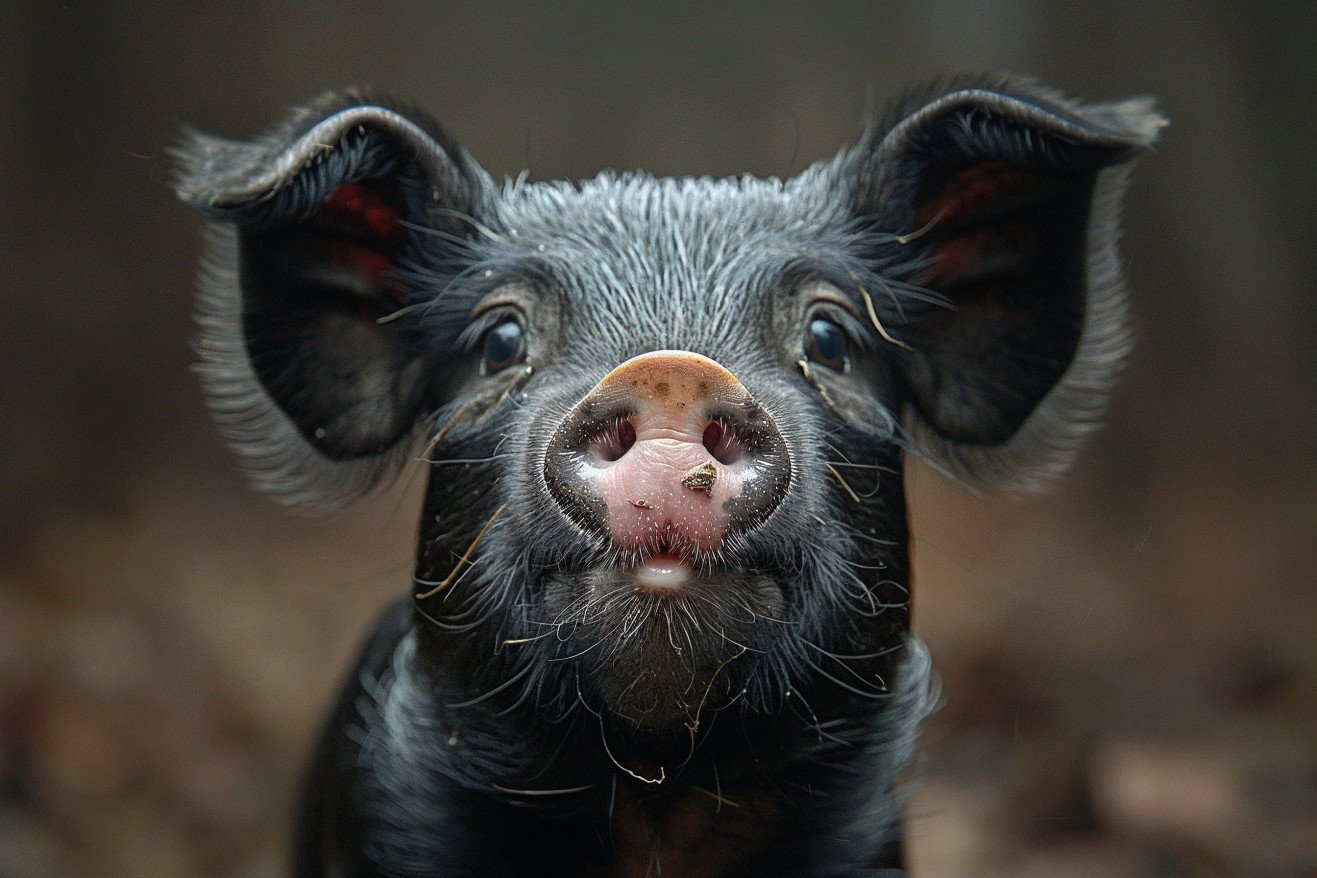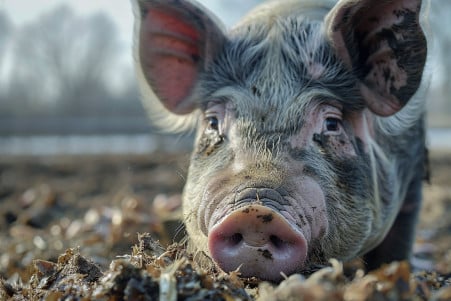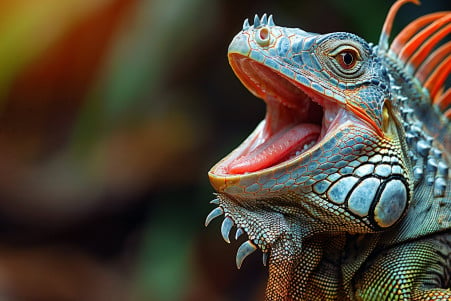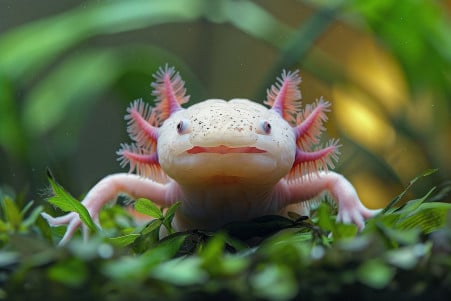The Toothful Truth: Can Pigs Actually Chew?
4 June 2024 • Updated 3 June 2024

Pigs are often associated with having snouts instead of mouths, but despite this popular image, pigs are actually highly intelligent animals with a full set of teeth that help them eat a varied diet. Pigs have teeth that are designed to help them grind up plant material and chew meat, including incisors for biting, molars for grinding, and even small tusks that function as extra incisors as pigs age.
Even though pigs may not seem like they have teeth, a closer look at the research on pig dental anatomy shows that there's a lot more to their teeth than meets the eye. This article will look at research from animal science, evolutionary biology, and veterinary medicine to explain the specialized teeth pigs have and how their dental health impacts their overall health. Knowing about a pig's teeth can tell you a lot about their diet, behavior, and how much they have in common with their wild ancestors.
Do pigs have teeth?
Dental Anatomy: The Unusual Teeth of Pigs
Pigs are born with a deciduous dentition of 28 teeth, including 8 sharp "needle teeth" that are the deciduous third incisors and canines and need to be clipped to prevent injury to the sow or other piglets, according to Colorado State University's dental anatomy overview. Their permanent dentition is made up of a total of 44 teeth - 3 incisors, 1 canine (tusk), 4 premolars, and 3 molars in each quadrant of the mouth.
Pig teeth, like human teeth, are covered in enamel to protect the teeth, have cementum covering the root, and are lined with dentin in the pulp cavity, which is responsible for several important functions. However, the teeth are structured and positioned to accommodate an omnivorous diet - the molars are unevenly spaced and shaped to help with grinding plant material while the incisors and canines are designed to help with tearing flesh.
In particular, boars have canine teeth or tusks that grow continuously throughout their lives, with the lower tusks sharpened by rubbing against the upper tusks, which makes them a dangerous weapon according to Colorado State. According to the North American Pet Pig Association, these tusks essentially act as additional incisors when it comes to biting.
Teeth Eruption: From Piglet to Adult Pig
Piglets are born with some deciduous teeth already erupted, which helps them eat their omnivorous diet from the moment they are born. A study in the Journal of Animal Science found that the deciduous dentition of domestic pigs consists of 28 teeth, with 8 needle teeth in each quadrant that erupt between 2-12 weeks before birth.
Permanent teeth then erupt between 4-20 months of age. A study in PubMed found that the timing and sequence of deciduous tooth eruption can be affected by sex, birth weight, and early weight gain. Most teeth erupt earlier in heavier piglets.
It's also worth noting that pig enamel is soft and porous at the time of eruption but then matures and hardens within the first 4 weeks, eventually reaching a mineral density and hardness similar to healthy human enamel, according to a study in Frontiers in Physiology. The permanent dentition is typically complete by 1.5-2 years of age, although the tusks will continue to grow throughout the pig's life.
Evolutionary Adaptations: Following Pig Dental Evolution
By examining the teeth of pigs, researchers can learn more about the domestication of pigs and the evolutionary changes that have occurred as pigs have evolved from their wild ancestors, the wild boar. For example, there are differences in tooth size, crown formation time, and enamel extension rates between domestic pigs and wild boar. In a study that appeared in PMC, the final crown dimensions of the second molar were not significantly different, but the mean crown formation time was much shorter in domestic pigs than in wild boar. This was due to a higher enamel extension rate in domestic pigs, not differences in the daily enamel secretion rate.
These differences in pig teeth are thought to be associated with changes in life-history traits and underlying developmental parameters that occurred during the domestication process, as explained in this Penn Today article. While it can be difficult to tell the difference between the teeth of domestic pigs and wild boar, some things, like linear enamel hypoplasia, can provide information about the living conditions and stresses the animals experienced. In addition, a comparison of the electron density of pig and human molars shows similarities and differences that are a result of the different evolutionary paths of the two species.
Knowing about these dental adaptations and what they reveal about pig domestication and evolution can help us better understand the special traits and behaviors of these interesting animals.
Dental Health and Feeding Behaviors
Pig teeth are adapted to meet the needs of an omnivorous diet and the feeding behaviors of pigs. A study in PLOS ONE explains that pigs have a generalist oral morphology, including bunodont teeth, that enables pigs to change the amplitude and variability of their chewing cycles in response to changes in food properties such as toughness and stiffness. This enables pigs to efficiently chew a variety of foods by changing the way the food interacts with their teeth.
Good dental health is important for pigs, and dental problems such as missing teeth, periodontal disease, and tooth fractures can affect their overall health. The Journal of Swine Health and Production explains that common dental abnormalities in pigs include missing first premolars, supernumerary roots on canines, and persistent deciduous teeth. While some dental procedures like clipping needle teeth in piglets and tusk trimming can help prevent injuries, they also present animal welfare concerns according to research in PMC.
Dental Care and Management for Pet and Livestock Pigs
Both pet and livestock pigs require proper dental care and management to ensure their health and well-being. The Midwestern University Animal Health Institute recommends annual professional dental cleanings, tusk trims, and potential tooth extractions performed under general anesthesia for pet pigs.
On farms, techniques such as clipping needle teeth and managing litter size can be used to prevent injuries caused by sharp teeth, according to the Merck Veterinary Manual. Meanwhile, environmental enrichment and increasing milk yield can help reduce teat competition and the facial/teat lesions that come with it, per a study in PMC.
Older pigs can experience dental problems such as abscesses, which can be treated with examination, radiography, and potential tooth extractions, according to the Merck Veterinary Manual. Because dental health can have a direct impact on pigs' quality of life, it's important to make sure their dental care is properly managed.
Conclusion: What Pig Teeth Tell Us
Pig teeth are a unique and specialized dental system that has adapted to the animal's omnivorous diet and evolutionary history. Understanding the development, structure, and function of pig teeth can provide insights into pig behavior, health, and well-being. Proper dental care and management are essential for pet and livestock pigs to prevent dental issues and maintain overall health.
In addition, studying pig teeth can help researchers learn more about biomineralization, evolution, and domestication. As intelligent and complex animals, ensuring good dental health is an important part of caring for and managing pigs.


